2013 FORD SUPER DUTY oil level
[x] Cancel search: oil levelPage 11 of 95
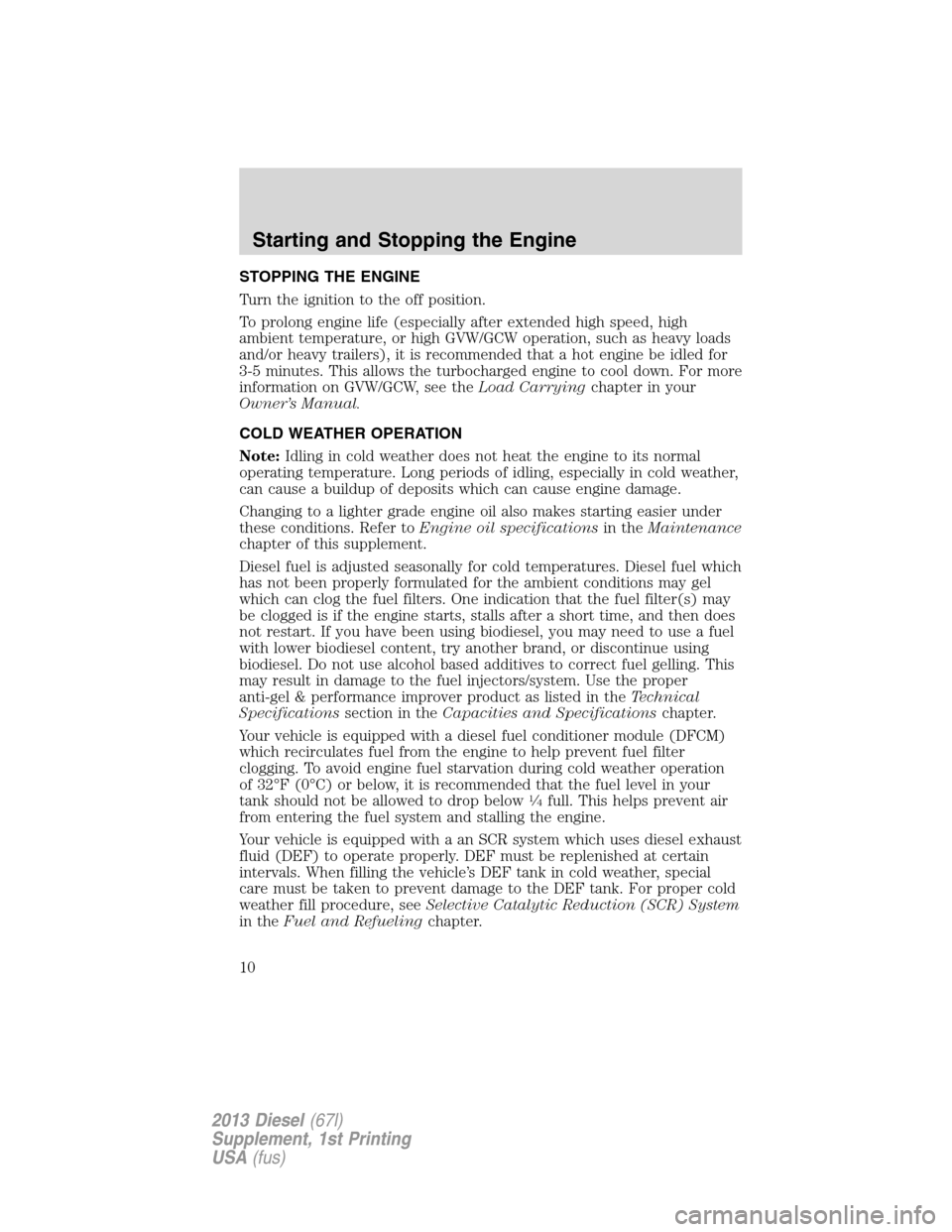
STOPPING THE ENGINE
Turn the ignition to the off position.
To prolong engine life (especially after extended high speed, high
ambient temperature, or high GVW/GCW operation, such as heavy loads
and/or heavy trailers), it is recommended that a hot engine be idled for
3-5 minutes. This allows the turbocharged engine to cool down. For more
information on GVW/GCW, see theLoad Carryingchapter in your
Owner’s Manual.
COLD WEATHER OPERATION
Note:Idling in cold weather does not heat the engine to its normal
operating temperature. Long periods of idling, especially in cold weather,
can cause a buildup of deposits which can cause engine damage.
Changing to a lighter grade engine oil also makes starting easier under
these conditions. Refer toEngine oil specificationsin theMaintenance
chapter of this supplement.
Diesel fuel is adjusted seasonally for cold temperatures. Diesel fuel which
has not been properly formulated for the ambient conditions may gel
which can clog the fuel filters. One indication that the fuel filter(s) may
be clogged is if the engine starts, stalls after a short time, and then does
not restart. If you have been using biodiesel, you may need to use a fuel
with lower biodiesel content, try another brand, or discontinue using
biodiesel. Do not use alcohol based additives to correct fuel gelling. This
may result in damage to the fuel injectors/system. Use the proper
anti-gel & performance improver product as listed in theTechnical
Specificationssection in theCapacities and Specificationschapter.
Your vehicle is equipped with a diesel fuel conditioner module (DFCM)
which recirculates fuel from the engine to help prevent fuel filter
clogging. To avoid engine fuel starvation during cold weather operation
of 32°F (0°C) or below, it is recommended that the fuel level in your
tank should not be allowed to drop below
1�4full. This helps prevent air
from entering the fuel system and stalling the engine.
Your vehicle is equipped with a an SCR system which uses diesel exhaust
fluid (DEF) to operate properly. DEF must be replenished at certain
intervals. When filling the vehicle’s DEF tank in cold weather, special
care must be taken to prevent damage to the DEF tank. For proper cold
weather fill procedure, seeSelective Catalytic Reduction (SCR) System
in theFuel and Refuelingchapter.
Starting and Stopping the Engine
10
2013 Diesel(67l)
Supplement, 1st Printing
USA(fus)
Page 12 of 95

In cold weather below 32°F (0°C), the engine may slowly increase to a
higher idle speed if left idling in P (Park). As the engine warms-up, the
engine sound level decreases due to the activation of PCM-controlled
sound reduction features.
If your vehicle is operated in a heavy snow storm or blowing snow
conditions, the engine air induction may become partially clogged with
snow and/or ice. If this occurs, the engine may experience a significant
reduction in power output. At the earliest opportunity, clear all the snow
and/or ice away from inside the air filter assembly. Remove the air
cleaner cover and the pleated paper filter, leaving the foam filter in and
remove any snow or ice. Make sure the foam filter is installed correctly
in place. Remove any debris, snow and/or ice on the foam filter by
brushing the surface with soft brush. Do not use water, solvents, or a
hard brush for cleaning the foam filter.
In order to operate the engine in temperatures of 32°F (0°C) or lower,
read the following instructions:
•Make sure that the batteries are of sufficient size and are fully
charged. Check other electrical components to make sure they are in
optimum condition.
•Use the proper coolant solution at the concentration recommended to
protect the engine against damage from freezing.
•Try to keep the fuel tank full as much as possible at the end of
operation to prevent condensation in the fuel system.
•Make sure you use proper cold weather engine oil and that it is at its
proper level. Also, if necessary, make sure to follow the engine oil and
filter change schedule found under theSpecial operating conditions
section listed in thescheduled maintenance information.
•At temperatures of -10°F (-23°C) or below, it is recommended that
you use an engine block heater to improve cold engine starting.
•If operating in arctic temperatures of -20°F (-29°C) or lower, consult
your truck dealer for information about special cold weather
equipment and precautions.
The following cold weather idling guidelines are recommended:
•Motorcraft® cetane improvers or non-alcohol-based cetane improvers
from a reputable manufacturer may be used as needed.
•Maintain the engine cooling system properly.
•Avoid shutting the engine down after an extensive idling period. Drive
the vehicle for several miles with the engine at normal operating
temperatures under a moderate load.
•Consider using an engine block heater.
•For extended idle times use an approved idle speed increase device.
Starting and Stopping the Engine
11
2013 Diesel(67l)
Supplement, 1st Printing
USA(fus)
Page 20 of 95
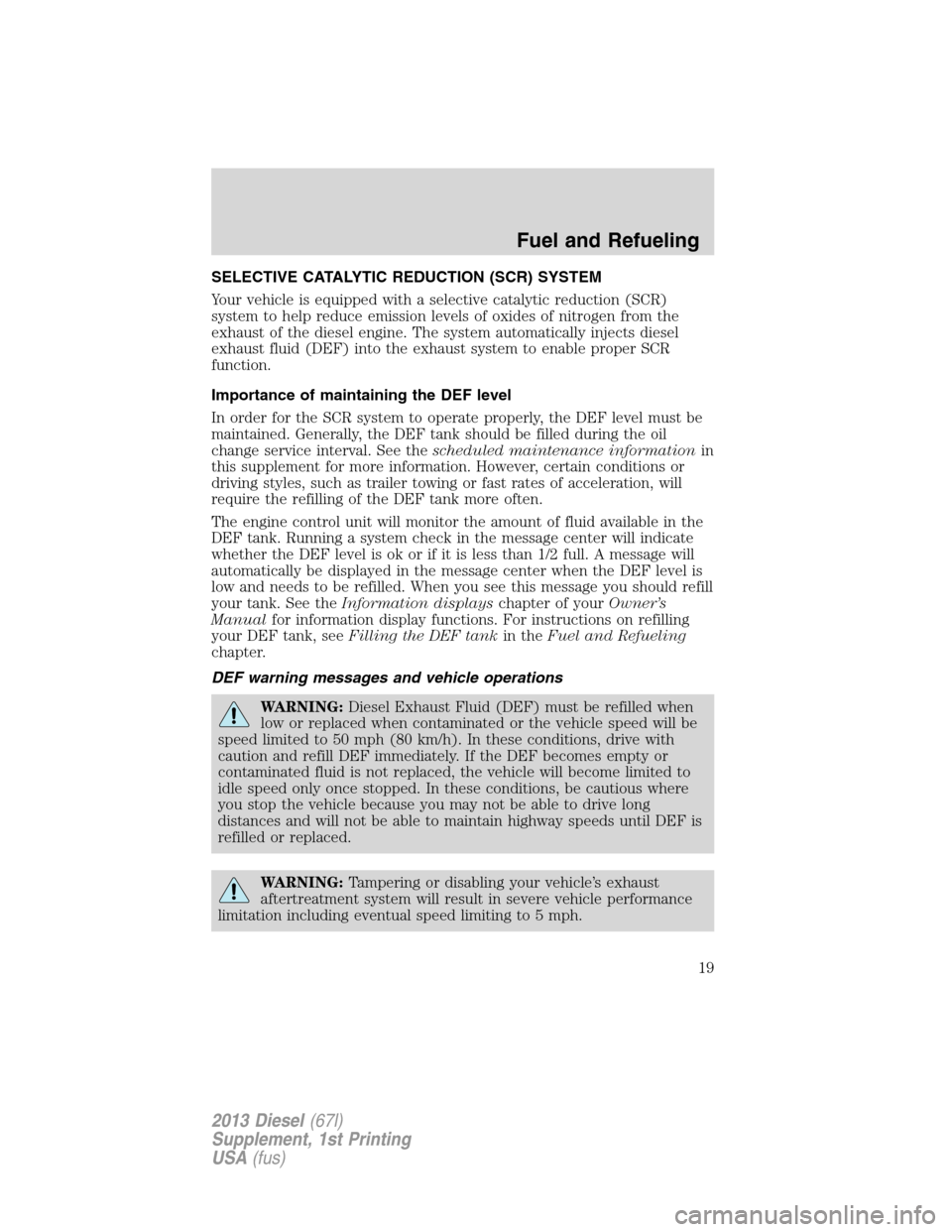
SELECTIVE CATALYTIC REDUCTION (SCR) SYSTEM
Your vehicle is equipped with a selective catalytic reduction (SCR)
system to help reduce emission levels of oxides of nitrogen from the
exhaust of the diesel engine. The system automatically injects diesel
exhaust fluid (DEF) into the exhaust system to enable proper SCR
function.
Importance of maintaining the DEF level
In order for the SCR system to operate properly, the DEF level must be
maintained. Generally, the DEF tank should be filled during the oil
change service interval. See thescheduled maintenance informationin
this supplement for more information. However, certain conditions or
driving styles, such as trailer towing or fast rates of acceleration, will
require the refilling of the DEF tank more often.
The engine control unit will monitor the amount of fluid available in the
DEF tank. Running a system check in the message center will indicate
whether the DEF level is ok or if it is less than 1/2 full. A message will
automatically be displayed in the message center when the DEF level is
low and needs to be refilled. When you see this message you should refill
your tank. See theInformation displayschapter of yourOwner’s
Manualfor information display functions. For instructions on refilling
your DEF tank, seeFilling the DEF tankin theFuel and Refueling
chapter.
DEF warning messages and vehicle operations
WARNING:Diesel Exhaust Fluid (DEF) must be refilled when
low or replaced when contaminated or the vehicle speed will be
speed limited to 50 mph (80 km/h). In these conditions, drive with
caution and refill DEF immediately. If the DEF becomes empty or
contaminated fluid is not replaced, the vehicle will become limited to
idle speed only once stopped. In these conditions, be cautious where
you stop the vehicle because you may not be able to drive long
distances and will not be able to maintain highway speeds until DEF is
refilled or replaced.
WARNING:Tampering or disabling your vehicle’s exhaust
aftertreatment system will result in severe vehicle performance
limitation including eventual speed limiting to 5 mph.
Fuel and Refueling
19
2013 Diesel(67l)
Supplement, 1st Printing
USA(fus)
Page 44 of 95
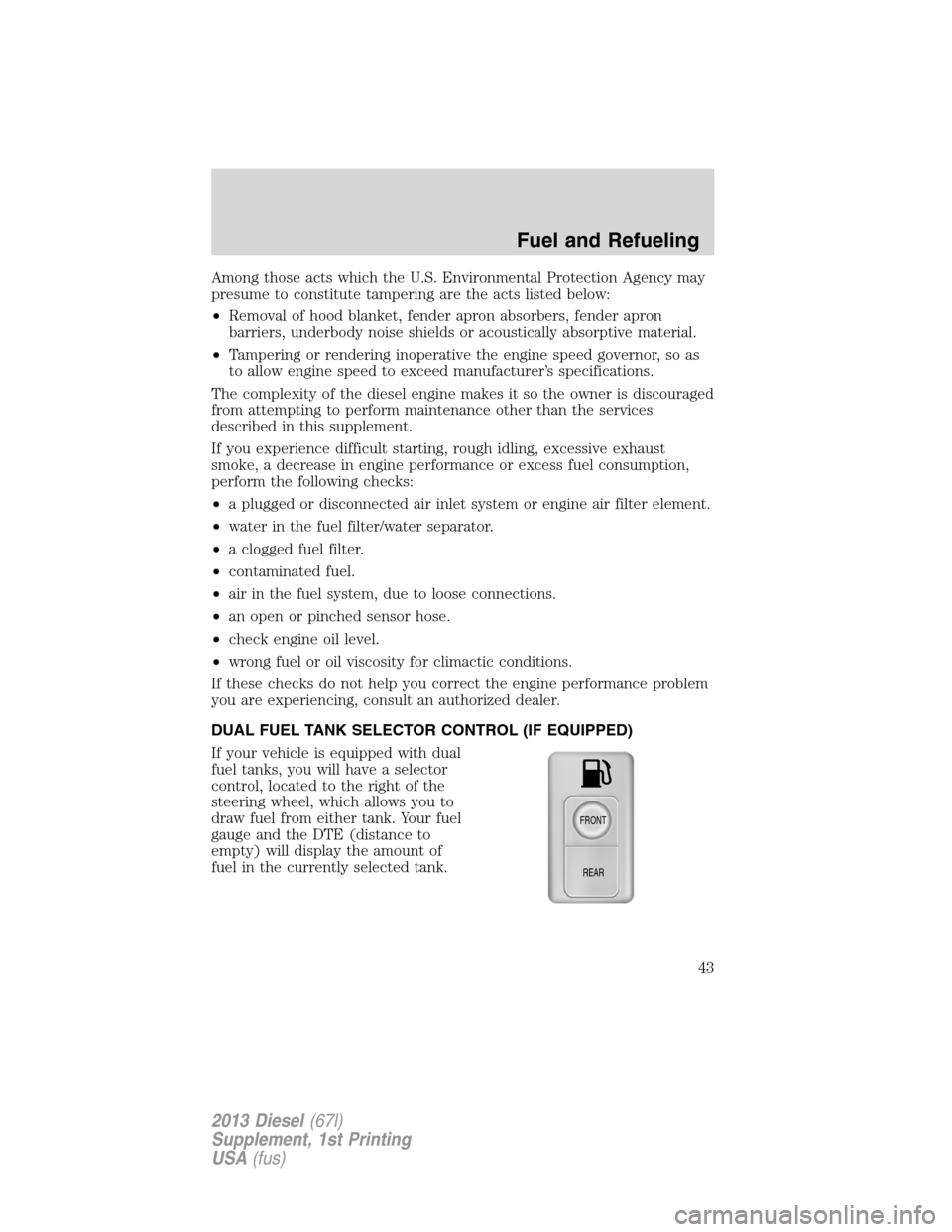
Among those acts which the U.S. Environmental Protection Agency may
presume to constitute tampering are the acts listed below:
•Removal of hood blanket, fender apron absorbers, fender apron
barriers, underbody noise shields or acoustically absorptive material.
•Tampering or rendering inoperative the engine speed governor, so as
to allow engine speed to exceed manufacturer’s specifications.
The complexity of the diesel engine makes it so the owner is discouraged
from attempting to perform maintenance other than the services
described in this supplement.
If you experience difficult starting, rough idling, excessive exhaust
smoke, a decrease in engine performance or excess fuel consumption,
perform the following checks:
•a plugged or disconnected air inlet system or engine air filter element.
•water in the fuel filter/water separator.
•a clogged fuel filter.
•contaminated fuel.
•air in the fuel system, due to loose connections.
•an open or pinched sensor hose.
•check engine oil level.
•wrong fuel or oil viscosity for climactic conditions.
If these checks do not help you correct the engine performance problem
you are experiencing, consult an authorized dealer.
DUAL FUEL TANK SELECTOR CONTROL (IF EQUIPPED)
If your vehicle is equipped with dual
fuel tanks, you will have a selector
control, located to the right of the
steering wheel, which allows you to
draw fuel from either tank. Your fuel
gauge and the DTE (distance to
empty) will display the amount of
fuel in the currently selected tank.
FRONT
REAR
Fuel and Refueling
43
2013 Diesel(67l)
Supplement, 1st Printing
USA(fus)
Page 50 of 95
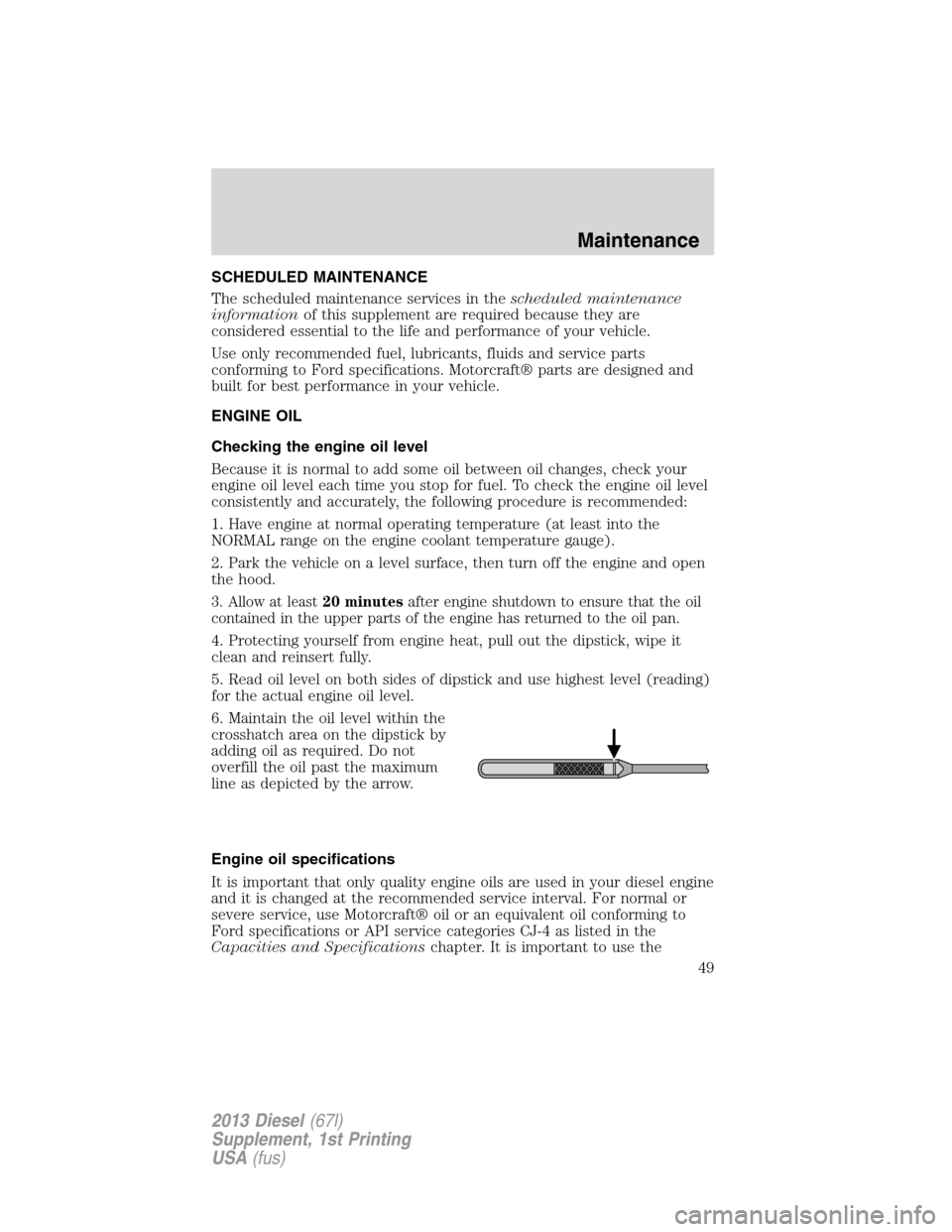
SCHEDULED MAINTENANCE
The scheduled maintenance services in thescheduled maintenance
informationof this supplement are required because they are
considered essential to the life and performance of your vehicle.
Use only recommended fuel, lubricants, fluids and service parts
conforming to Ford specifications. Motorcraft® parts are designed and
built for best performance in your vehicle.
ENGINE OIL
Checking the engine oil level
Because it is normal to add some oil between oil changes, check your
engine oil level each time you stop for fuel. To check the engine oil level
consistently and accurately, the following procedure is recommended:
1. Have engine at normal operating temperature (at least into the
NORMAL range on the engine coolant temperature gauge).
2. Park the vehicle on a level surface, then turn off the engine and open
the hood.
3. Allow at least20 minutesafter engine shutdown to ensure that the oil
contained in the upper parts of the engine has returned to the oil pan.
4. Protecting yourself from engine heat, pull out the dipstick, wipe it
clean and reinsert fully.
5. Read oil level on both sides of dipstick and use highest level (reading)
for the actual engine oil level.
6. Maintain the oil level within the
crosshatch area on the dipstick by
adding oil as required. Do not
overfill the oil past the maximum
line as depicted by the arrow.
Engine oil specifications
It is important that only quality engine oils are used in your diesel engine
and it is changed at the recommended service interval. For normal or
severe service, use Motorcraft® oil or an equivalent oil conforming to
Ford specifications or API service categories CJ-4 as listed in the
Capacities and Specificationschapter. It is important to use the
Maintenance
49
2013 Diesel(67l)
Supplement, 1st Printing
USA(fus)
Page 74 of 95
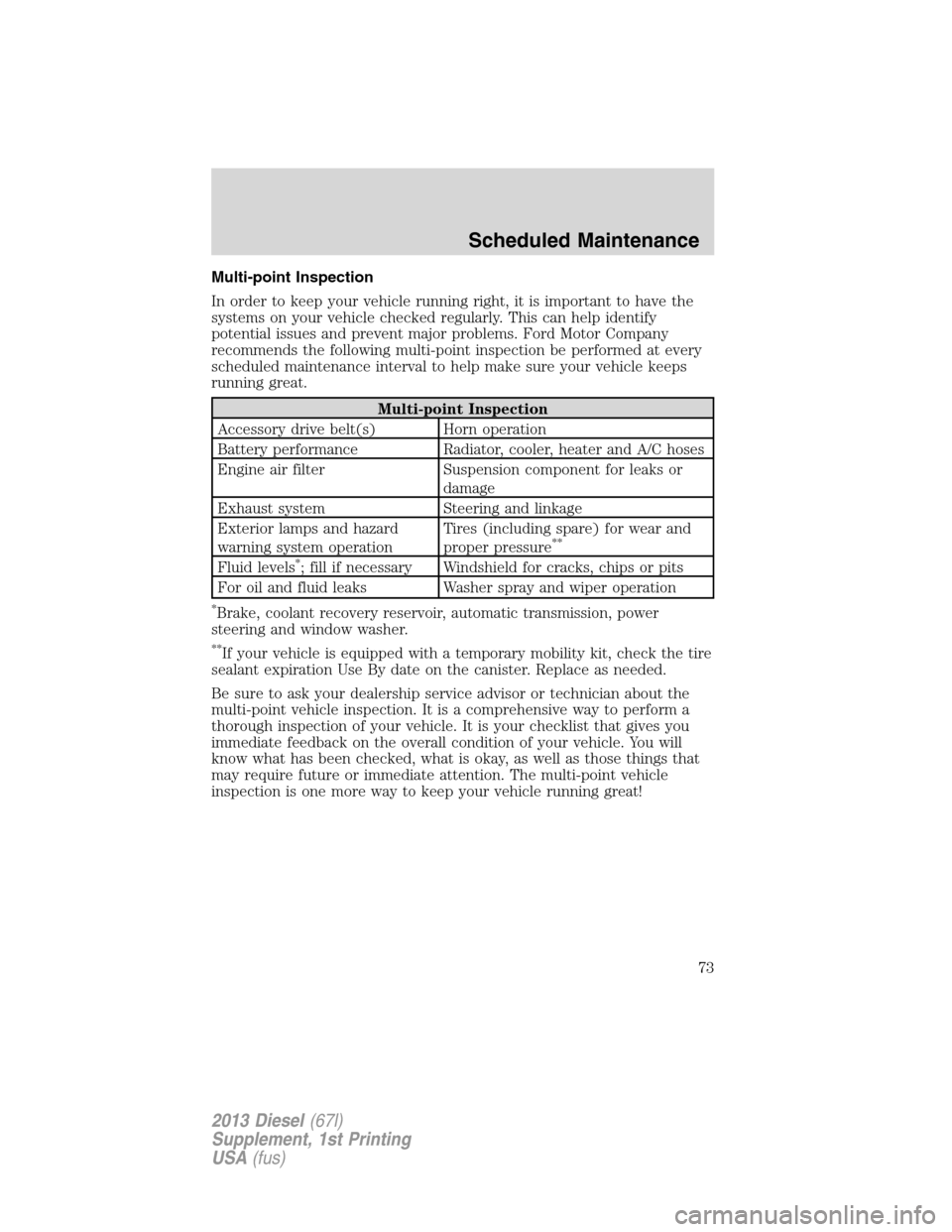
Multi-point Inspection
In order to keep your vehicle running right, it is important to have the
systems on your vehicle checked regularly. This can help identify
potential issues and prevent major problems. Ford Motor Company
recommends the following multi-point inspection be performed at every
scheduled maintenance interval to help make sure your vehicle keeps
running great.
Multi-point Inspection
Accessory drive belt(s) Horn operation
Battery performance Radiator, cooler, heater and A/C hoses
Engine air filter Suspension component for leaks or
damage
Exhaust system Steering and linkage
Exterior lamps and hazard
warning system operationTires (including spare) for wear and
proper pressure
**
Fluid levels*; fill if necessary Windshield for cracks, chips or pits
For oil and fluid leaks Washer spray and wiper operation
*Brake, coolant recovery reservoir, automatic transmission, power
steering and window washer.
**If your vehicle is equipped with a temporary mobility kit, check the tire
sealant expiration Use By date on the canister. Replace as needed.
Be sure to ask your dealership service advisor or technician about the
multi-point vehicle inspection. It is a comprehensive way to perform a
thorough inspection of your vehicle. It is your checklist that gives you
immediate feedback on the overall condition of your vehicle. You will
know what has been checked, what is okay, as well as those things that
may require future or immediate attention. The multi-point vehicle
inspection is one more way to keep your vehicle running great!
Scheduled Maintenance
73
2013 Diesel(67l)
Supplement, 1st Printing
USA(fus)
Page 77 of 95

Normal Scheduled Maintenance1
At every oil change
interval as indicated
by the information
displayChange engine oil and filter.2
Refill diesel exhaust fluid tank.
Rotate tires3, inspect tire wear and measure tread
depth.
Perform multi-point inspection (recommended).
Inspect air filter restriction gauge. Replace filter if
necessary.
Inspect automatic transmission fluid level.
Inspect brake pads, shoes, rotors, drums, brake
linings, hoses and parking brake.
Inspect engine and secondary coolant level and
hoses.
Inspect exhaust system and heat shields.
Inspect front axle and U-joints. Lubricate if equipped
with grease fittings (4WD vehicles).
Inspect steering linkage, ball joints, suspension,
tie-rod ends, driveshaft and U-joints. Lubricate if
equipped with grease fittings.
Inspect wheels and related components for abnormal
noise, wear, looseness or drag.
1Do not exceed one year or 10000 miles (16000 kilometers) between
service intervals.
2Reset your Intelligent Oil-Life Monitor® after each engine oil and filter
change. See theInformation Displaychapter of yourOwner’s Manual.
3Vehicles equipped with dual rear wheels should rotate the front wheels
when specified; rear wheels only if unusual wear is noted.
Additional Maintenance Items1
Every 15000 miles
(24000 km)Inspect engine and secondary cooling system
concentration (freeze-point protection), additive
(corrosion inhibitor) strength, coolant level and
hoses.
2
Every 22500 miles
(36000 km)Replace engine- and frame-mounted fuel filters.3
Scheduled Maintenance
76
2013 Diesel(67l)
Supplement, 1st Printing
USA(fus)